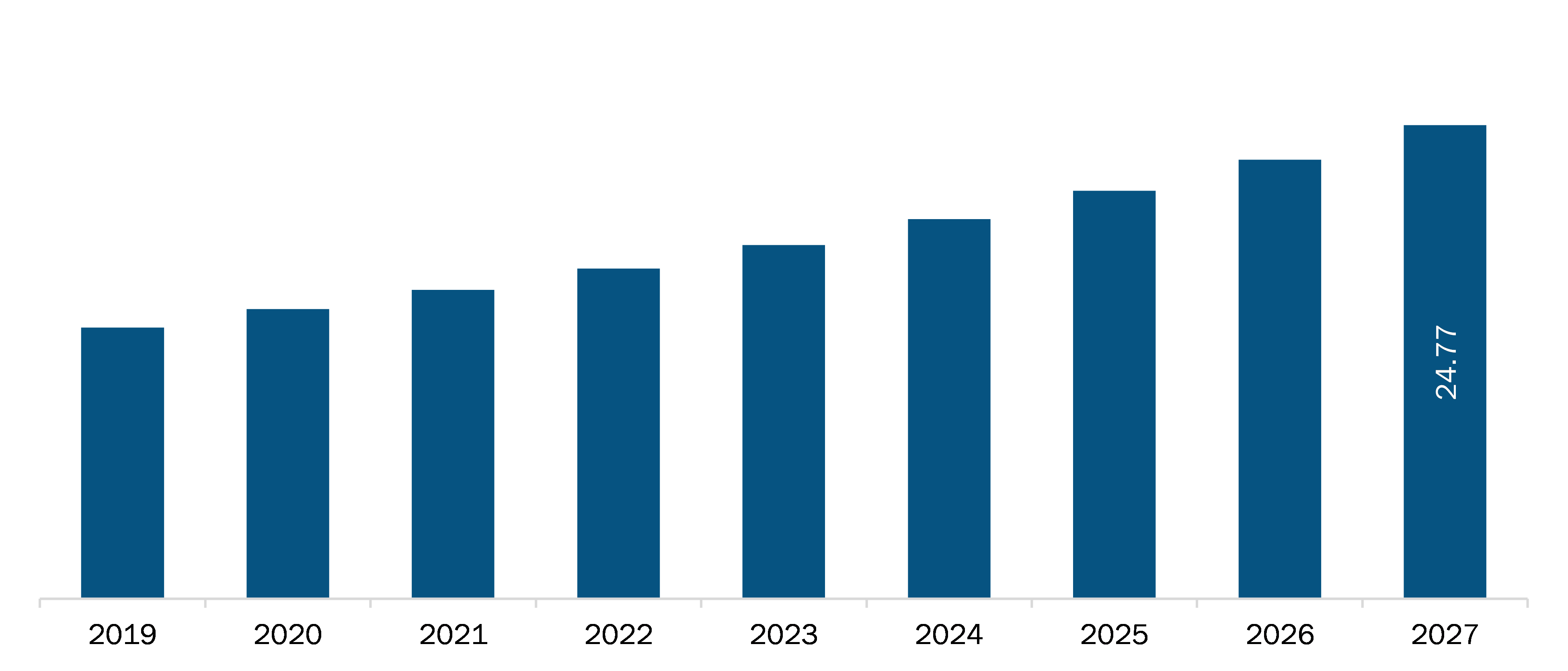The Middle East and Africa Artificial Intelligence (AI) in healthcare market is expected to reach US$ 5,713.28 million by 2027 from US$ 222.03 million in 2019; it is estimated to grow at a CAGR of 48.8% from 2020 to 2027.
The growth of the market is attributed to the driving factors such as rising application of artificial intelligence (AI) in healthcare market, growing investment in AI healthcare start-ups, and increasing cross-industry partnerships and collaborations. However, dearth of skilled AI workforce and imprecise regulatory guidelines for medical software hinder the market growth.
Artificial intelligence (AI) in healthcare sector is intended to considerably change clinicians' roles and everyday practices by accomplishing and analyzing data, make decisions, and conduct discussions. AI application in healthcare is getting progressively sophisticated, efficient, and quicker at a lower cost. Owing to the tremendous potential of AI and robotics in healthcare sector, they are gradually becoming a major part of the healthcare ecosystem. According to a CB Insights Report in 2020, ~86% of the healthcare providers, life science companies, and technology vendors depend on artificial intelligence technologies. Several healthcare providers are starting to offload certain parts of the care-pathways to artificial intelligence (AI) based automation. Also, numerous start-ups are developing AI-driven imaging and diagnostic solutions that are accountable for the growth of the market. Artificial Intelligence (AI) is applied to aid cancer diagnosis and prognosis, imaging systems, and help reorganize the drug discovery and drug repurposing procedures. Therefore, a significant increase in the number of artificial intelligence start-ups in the healthcare sector is anticipated to positively influence the market growth during the forecast period.
The socio-economic condition of countries in the Middle East are widely affected by the COVID–19 pandemic. The UAE has employed artificial intelligence and smart solutions to battle the spread of COVID-19. For instance, in February 2021, two UAE-based health companies entered a partnership with Canada’s Laipac Technology to launch the world’s first artificial intelligence (AI)-powered rapid COVID-19 antigen test. However, it is expected that until the availability of vaccines in the regional governments, the challenges are supposed to continue for the market.

- This FREE sample will include data analysis, ranging from market trends to estimates and forecasts.
Middle East and Africa Artificial Intelligence (AI) in Healthcare Market Segmentation
By Component
- Software Solution
- Hardware
- Services
By Application
- Robot Assisted Surgery
- Virtual Assistants
- Administrative Workflow Assistants
- Connected Machines
- Diagnosis
- Clinical Trials
- Fraud Detection
- Cybersecurity
- Dosage Error Reduction
- Other
By Country
- Hospitals and Healthcare Providers
- Patients
- Pharma and Biotech Companies
- Healthcare Payers
- Others
By Country
- Saudi Arabia
- UAE
- South Africa
- Rest of Middle East and Africa
Company Profiles
- Alphabet Inc.
- General Electric Company
- Intel Corporation
- Koninklijke Philips N.V
- Microsoft Corporation
- NVIDIA CORPORATION
- Nuance Communications, Inc
- Siemens Healthineers AG
- Arterys Inc
- Johnson and Johnson Services, Inc.
Middle East and Africa Artificial Intelligence (AI) in Healthcare Report Scope
| Report Attribute | Details |
|---|---|
| Market size in 2019 | US$ 222.03 Million |
| Market Size by 2027 | US$ 5,713.28 Million |
| CAGR (2020 - 2027) | 48.8% |
| Historical Data | 2017-2018 |
| Forecast period | 2020-2027 |
| Segments Covered |
By Component
|
| Regions and Countries Covered |
Middle East and Africa
|
| Market leaders and key company profiles |
|
- Historical Analysis (2 Years), Base Year, Forecast (7 Years) with CAGR
- PEST and SWOT Analysis
- Market Size Value / Volume - Regional, Country
- Industry and Competitive Landscape
- Excel Dataset
Recent Reports
Testimonials
Reason to Buy
- Informed Decision-Making
- Understanding Market Dynamics
- Competitive Analysis
- Identifying Emerging Markets
- Customer Insights
- Market Forecasts
- Risk Mitigation
- Boosting Operational Efficiency
- Strategic Planning
- Investment Justification
- Tracking Industry Innovations
- Aligning with Regulatory Trends





















 Get Free Sample For
Get Free Sample For